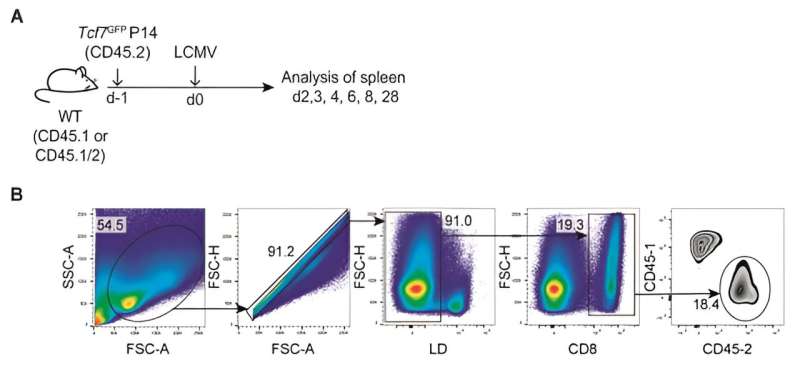Scientists solve 18-year-old mystery and find the once-elusive source of a critical T cell population
Originally published by Delthia Ricks , Medical Xpress, on December 28, 2023
Presence of Tcf7+ CD8+ T cells during the primary response to infection. (A) Experimental schematic: Naïve P14 cells (CD45.2) were transferred into congenically distinct B6 mice (CD45.1) that were subsequently infected with LCMV (Arm or WE strain). On the indicated day of infection, P14 cells present in the spleen (unless indicated otherwise) were characterized using flow cytometry. (B) Live cells were gated using FSC-A and SSC.A, followed by doublet discrimination using FSC-H/FSC-A. Next, singlets were gated for alive cells, CD8+ and congenic markers CD45.1 and CD45.2 were used to gate P14 cells. Credit: Science Immunology (2023). DOI: 10.1126/sciimmunol.adh3113
One of the more rigorous debates in immunology has centered on the origin of an enigmatic T cell population that possesses properties imparting memory and stem cell–like qualities, but facts about their genesis were so elusive that debate has raged for nearly two decades about the source of these vital immune system constituents.
Now, scientists in Switzerland have pinpointed precursors to cells known as stem-like central memory T cells—TCM cells—and tracked their transformation from precursors to active players in the immune response. The cells themselves were first identified in 2005.
Since that time, immunologists have been on the hunt for the origin of stem-like central memory T cells. Early hints suggested they were possibly a subset of CD8+ T cells, widely known interchangeably as cytotoxic or killer T cells. These immune system warriors are recognized for their defense against pathogens and relentless round-the-clock surveillance in search of cancer cells.


Comments
Post a Comment